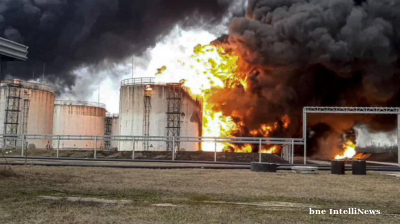A camera crew from Associated Press was granted access to the Fire Point factory at an undisclosed location inside Ukraine to witness the production of Ukraine’s new Flamingo cruise missile.
Iryna Terekh, head of production at drone manufacturer Fire Point and a former architect, joined in 2023 when the target was 30 drones per month. Output has since surged to about 100 drones per day, each costing $55,000. She said Fire Point’s FP-1, with a 60kg payload, is responsible for 60% of Ukrainian strikes deep inside Russian territory. But the factory has recently upgraded and moved on to the serial production of the Flamingo missiles, so named because a factory error meant the first prototypes came out pink. Fire Point is producing roughly one Flamingo per day, and by October they hope to build capacity to make seven per day, Terekh said.
Unanswered questions
The sudden appearance of the jet powered Flamingo and its rapidly accelerating production rate has raised a series of questions that have led some to question the Ukrainian origins of the missile – at this point pure speculation.
“The Ukrainian company claims they aim to produce 8 Flamingos per day in October. This raises a red flag for me, suggesting they are probably not manufacturing any missiles but rather assembling kits that arrive pre-made, in an effort by European countries to evade the missile treaty, which limits these countries from exporting long-range missiles to Ukraine,” journalist and Ukraine-watcher Patrica Marins wrote in a social media post.
The release of AP’s report is also extremely timely. Russia recently did the same thing, allowing an unidentified camera crew into a factory in its vast hinterland churning out hundreds of upgraded Shahed drones. Since Moscow launched a devastating missile barrage on Kyiv and other cities, the number of missile and drone attacks has quadrupled to some 750 per day.
Now Kyiv has countered with its own drone and missile factory report. Ukraine is looking for leverage in the mooted bilateral meeting between Russian President Vladimir Putin and Zelenskiy. Putin believes that he has the upper hand on the battlefield as the Armed Forces of Russia (AFR) continues to make steady, albeit slow, progress on the battlefield and is prepared to fight on, according to reports, if the peace talks fail. Ukraine needs to show it can hold its own in a protracted war.
The appearance of powerful Ukrainian missiles that can cause real damage to Russia’s military and energy infrastructure will improve Zelenskiy's hand at the negotiating table and comes in the week where Kyiv struck Russia’s crucial Druzhba oil pipeline to Hungary for a second time in a week.
“Maybe all of this is just a staged show to strengthen Ukraine’s position in negotiations,” says Marins. “We’re at a crossroads: either Ukraine is bluffing, or it’s preparing to escalate the war to another level.”
Ukraine’s defence industry
Ukraine’s defence industry has been growing fast from a standing start at the start of the war with Russia in February 2022. Last month Ukrainian President Volodymyr Zelenskiy said that Ukraine now provides itself with between 40% and 50% of all the arms it needs and Kyiv’s foreign partners are increasingly investing in local production under the successful Danish model rather than digging into their dwindling stockpiles to supply Ukraine with materiel.
While Ukraine has amazed the world with its innovative use of drones and ramped up production to produce over 2mn units this year, it produces almost no missiles at all. Russia has a long history of missile production that gives it a huge strategic advantage on the battlefield and has since caught up with drone production. But after the US ran out of money for Ukraine at the start of last year, the Kremlin used its high precision and powerful missiles to destroy all of Ukraine’s non-nuclear power infrastructure.
As Ukraine faces the same problem this year – US Secretary for Defence Pete Hegseth briefly cut off Ukraine’s supplies of military hardware again in July until Trump’s ““big announcement” Europe-will-pay deal – it still lacks the ability to make the missiles it needs to target Russian military and economic assets in the hinterland to denigrate Moscow’s ability to supply its troops and pay for the war.
The Western allies have been sparing in their supply of missiles. The US finally agreed to send Ukraine the most powerful HIMARS and ATACMS in 2022 and 2023 respectively, but they came with a long list of restrictions. Likewise, Europe has supplied Ukraine with its Franco-British Storm Shadow missiles, but those went out of production 15 years ago and the first batch from revived production are only due to arrive this autumn. And Berlin has flatly refused to supply Ukraine with its state-of-the-art Taurus cruise missiles, despite lifting restrictions on their export in theory, that would be a game changer. So, Ukraine has begun to produce its own missiles, which it is free to use as it likes.
Missile arms race
Russia is well ahead in the missile arms race, leading some to ask if Ukraine can go it alone. Given the current discussions on providing Ukraine with security guarantees, one of the most discussed options on the table is not to provide Ukraine with Nato-lite bilateral security promises, as suggested by Italy’s Prime Minister Giorgia Meloni in March, but simply to beef up the Armed Forces of Ukraine (AFU) so that Ukraine can provide for its own security.
That means providing Ukraine with the powerful long-range ballistic and cruise missiles it currently lacks. Russia has ramped up its missile production and is currently making an estimated 1,200 per year or 23 a week. But Russia is at the limit of its missile production. Everything it produces is immediately used.
Thanks to its Cold War arms race legacy, Russia has developed an extensive mix of high- and low-tech missiles and bombs that vastly outgun Ukraine’s current production abilities. At the top of the range are the new hypersonic missiles that Putin showcased during his 2018 state of the nation speech and are so fast he claims that the US has no counter to them. The newest addition to this class of ICBM is the Oreshnik missile that has a range of 5,000km and can reach any European capital in under 20 minutes. Russia recently agreed to station some Oreshniks in Belarus and last year already began to store some of its nuclear missiles there. At the low end of the scale are Russia’s repurposed FAB glide bombs – a WWII gravity bomb with wings and an engine strapped onto its back that has a massive payload of up to 3,000kg of explosives.
Ukraine has been developing and producing cruise missiles to counter the Russian arsenal. An early entry to the war was the home-made surface-to-ship Neptune missile that spectacularly sank Russia’s Black Sea fleet flagship, the Moskva in April 2022. The missile has since been adapted so that it can be used against land-based targets.
Since then, progress has been slow. Zelenskiy announced in September last year that it has developed and tested its own cruise missile, the Palyanytsia. It was first deployed in August 2024, and it has a range of approximately 600-700 km, allowing it to target Russian military airfields and Bankova doesn’t need US permission to use it. The Palyanytsia is a hybrid between a missile and a drone, which makes it unique and hard for Russian defences to counter, however, since Zelenskiy’s announcement there have been battlefield reports of its use.
The Flamingo is a quantum leap ahead from the Palyanytsia. The contrast between the slow development of the Palyanytsia, its limited capabilities and its lack of any impact on the fighting, compared to the sophistication, high production forecasts and range and power of the Flamingo have only fuelled speculation that the missile is actually foreign-made.
Features

BEYOND THE BOSPORUS: Prosecutors make move on “fictitious export schemes” of Istanbul Gold Refinery
Observers point to intra-regime gangs seizing each other’s wealth, remember Erdogan’s “Hello Fatih” phone calls and ponder whether wanted man Turgay Ciner is in London.

Taliban visit to India upsets Pakistan, signals New Delhi's changing Afghan posture
Coinciding with the visit, Pakistan conducted military operations inside Afghanistan, followed by airstrikes on multiple border towns. Retaliation against Pakistan's police training facilities and border outposts followed.

Pakistan’s India-shaped chip on the shoulder, and why a peaceful coexistence is as elusive as ever
Pakistan must first redefine how it sees India - not solely as a threat to be contained but as a neighbour with whom coexistence is unavoidable. That psychological leap has eluded generations of Pakistani leaders.

Trump shocked by China’s move on rare earths, threatens more 100% tariffs
"Some very strange things are happening in China!" Trump wrote in a post on his Truth Social account on October 10, adding "They are becoming very hostile."




